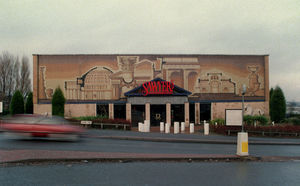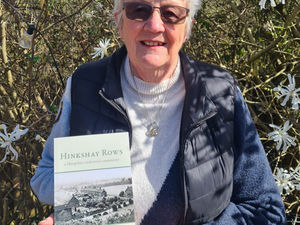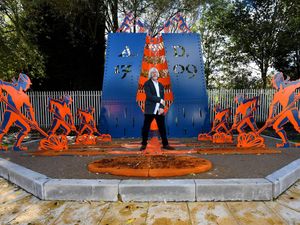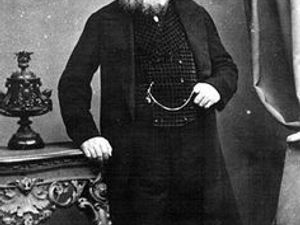The landmarks we have loved
The Iron Bridge. Dudley Castle. The Prince Albert statue in Wolverhampton, Lord Hill's column in Shrewsbury, Reuben Farley's bandstand in West Bromwich. Most towns have their famous landmarks, which instantly spring to mind.

But what about the lesser landmarks? The quirky, interesting or unusual features which have become part of the fabric of our community. Some have stood the test of time, others vanished almost as quickly as they appeared. What they all have in common, though, is that they have provided plenty of interesting points – and a useful point of reference when giving directions.
Here we look at a few of the best known:
*Roman Mosaic
For decades, the Roman Mosaic tile works at Burnt Tree Island at the gateway to Dudley, was one of the Black Country's most famous sights. True to its name, the building displayed a spectacular 90ft by 20ft mosaic depicting life during the days of the Roman Empire. To add to the drama, two statues of lions guarded the entrance of the building.
The mural, made from the company's tiles, was the work of Ernesto De Rosa, who trained as a mosaic artist in Florence before helping to set up the business in 1946. Another of his well-known works was a mural at a church in Edinburgh.
In 1988 Roman Mosaic moved to new premises in Bloomfield Road, Tipton, and the Burnt Tree site was bought by Bass Taverns. The pub chain converted it into a nightclub and restaurant called Sawyers, but agreed to retain the distinctive frontage. The stay of execution was short-lived, though, and in 1999 the company decided to convert the nightspot into a Toby Carvery. which meant getting rid of the artwork which was at odds with the chain's corporate image. Despite fierce opposition from councillors – and a last-minute attempt to get the mosaic listed – the landmark was lost.
One piece of the Roman Mosaic legacy still survives, though: the lion statues, which were due to have been destroyed with the mosaic, were saved by Tipton business leader Tony Roper. They were installed on a traffic island in Great Bridge, and have become something of a landmark in their own right.
*The Churchill screen
Another spectacular mosaic, the large stained glass window depicting the life of wartime leader Sir Winston Churchill was unveiled in Dudley's Churchill shopping precinct in 1969. However, the pioneering techniques used to make the window were soon found to be flawed, and pieces of glass started falling out. The main panels were removed for safety reasons in 1983 following a vandal attack, and in 1994 the precinct was converted into an indoor shopping centre.
Since then, the mural has been kept in storage at Himley Hall.
Dudley North MP Ian Austin, who said the window was a major influence on him becoming interested in politics as a youngster, has led a campaign for the window to be restored and reinstated in the town. He has been backed by Churchill's grandson, Sir Nicholas Soames, who visited the Churchill Centre in 2015 to mark the 50th anniversary of his grandfather's death.
*'Hollywood' sign at Dawley
When residents of the Dawley area of Telford woke up on June 6, 2010, they could barely their eyes. When they had gone to bed on Saturday night, the town's Paddock Mount was adorned by nothing more dramatic than a few felled tree stumps. The next morning, some Hollywood-style lettering spelling the name 'Dawley' had appeared on the hillside.
The sign was the work of artists Chris Hoofe, Ellen Davies, Fee Mapp, Graham Ward and Caroline Bills who climbed the hills under the cover of darkness and installed the 4ft high letters. A few days later they revealed how the work had been carried out with 'military precision', with the group painting their faces black so they would not be spotted, and using carpet to muffle the sound of the hammering.
The new landmark proved a big hit with people in the town, and Great Dawley parish council had intended adopting it. But sadly, vandals had other ideas, and within four days it had been attacked, with the 'W' destroyed and the other letters rearranged.
*Infamous fruit farm advert
In 1983 Councillor Tim Corbett caused an outcry when he used weedkiller to brand one of Shropshire's best-known beauty spots with a 60ft advert for his fruit farm.
Councillor Corbett, who ironically was a member of the county council's planning committee, burned the message into the slopes of The Lawley, part of the South Shropshire Hills at Church Stretton.
He told Shrewsbury magistrates that he had attempted to remove the sign when he realised how angry it made the community, but it was six weeks before the grass grew back.
Councillor Corbett was fined £200, the biggest penalty the court could impose. Although it might have been considered value for money, given the amount of publicity it generated.
*The Pink Shop
The name says it all, really. The bright pink paint finish has meant that few people will have difficulty spotting the convenience store in Albrighton. If it wasn't eye-catching enough, it was decorated with a bubble pattern a few years ago.
*Astle Bridge
In 1968, Jeff Astle scored West Bromwich Albion's winning goal in extra time of the FA Cup Final, turning him into an overnight hero. Over at the Round Step pub in Netherton, Dudley, an exuberant Albion fan decided to mark the occasion by walking outside and spraying 'Astle is King' on the nearby Primrose Bridge. The graffiti proved remarkably enduring, remaining in situ until 1993, when Dudley Council finally decided to remove it. But a couple of days later, it appeared again, this time with the added warning for the council to 'take note'. The 200-year-old bridge became affectionately known as 'Astle Bridge', and there were even moves to get it formally renamed.
In 1995 an image of the graffiti was used as the logo for the Dudley Winter Ale Festival, and Astle himself turned out to perform the official opening. At the same time, Albion fan Kenny Norton – by then working as an hotelier in Cornwall – revealed himself to be perpetrator behind the original graffiti.
In 2007, days before Albion were due to play arch-rivals Wolverhampton Wanderers, the slogan mysteriously disappeared, this time with no involvement from the council. Albion fans suspected their rivals were involved.
Then last year, 50 years since Astle's goal, the graffiti appeared once more – only to be covered over with black paint within 24 hours.
*'Car park for military vehicles'
When Dillon Brooks, licensee of the Old Three Pigeons in Nescliffe, near Shrewsbury, incurred the displeasure of the planning authorities when he started to amass a collection of historic military vehicle outside his pub.
The collection, included a glass-fibre replica of a Sherman tank, which had been used in the war film A Bridge Too Far, as well as Russian T-34 tank, a gun and various armoured cars.
Shrewsbury and Atcham Borough Council was not impressed, and suggested the Three Pigeons should apply for permission for a change of use to a car park for military vehicles. Police were also concerned that it was contributing to car crashes in the vicinity.
*And another tank
In 1994, Black Country property tycoon Tony Whittaker decided he wanted to do something to commemorate the 50th anniversary of the D-Day landings – and what better way to do it than by parking a Chieftain tank at the entrance to his premises?
But there is a much more personal story behind the tank, which has become a familiar sight outside the Delph Industrial Estate in Brierley Hill.
As a teenager Tony worked as an an apprentice at a brickworks at The Delph in Brierley Hill, where he was supervised by decorated Normandy veteran Stan Longmore.
One day Stan fell into the river while fishing, and Tony dived in to rescue him. Some 30 years later, when Stan died, the businessman was contacted by Stan's widow, saying he had left his medals to him as a thank-you for saving his life.
“I never knew what he’d done in the war, much less that he’d received the DSM from the King at Buckingham Palace. He never talked about it,” said Tony.
“There aren’t enough Stan Longmores in this world so when I had the opportunity to buy the tank around the time of the D-Day landings anniversary, I took it, and put it on the industrial estate in honour of Stan and those like him.”
It remains in place to this day, and 10 years ago was treated to a comprehensive paint restoration.
*Pole position
A stylish new house in Lichfield Road, Walsall, had everything a growing family could want when it went on the market in 2017: five bedrooms, a double garage, ample off-road parking – and a telegraph pole blocking the driveway.
Unsurprisingly, it proved as big an obstacle to selling the property as it did to parking the car.
*The tramp's camp
For 30 years, Josef 'Fred' Stawinoga, was a familiar sight in his makeshift camp on the central reservation of the Wolverhampton ring road. Passing motorists would often observe him watching his portable television powered by a car battery.
Attempts by the council to provide the Polish-born vagrant with more suitable accommodation were rebuffed. When offered a hostel place in 1987, he explained in broken English that he had been a prisoner of war and needed to be 'free'. The council did provide him with a new tent in 1996, and the police would help him keep his battery charged. He appeared to have gone up in the world in 1990, when a satellite dish appeared outside his camp.
When he died, in 2007, it was discovered he had left behind £34,000 in unclaimed pension money.





